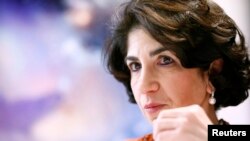Fabiola Gianotti, who this week takes the helm at CERN — home to world's largest particle accelerator, is seen as a new breed of scientist. Initially trained in arts and literature, she came to physics relatively late. She enjoys cooking, jogging, music and keeping her eye on the news, and notes the importance of being "a citizen of the world."
Gianotti "embodies for me what's much more the millennium physicist," said Dr. Monica Dunford, senior scientist at Germany's University of Heidelberg, who spent six years at CERN, the European Center for Nuclear Research. "Not so geeky, much more well-rounded, diverse, passionate."
"Fabiola brings freshness to science: She's incredibly energetic, incredibly passionate, has a lot of different talents. ... She has a degree in piano in addition to physics," Dunford said.
Gianotti, who succeeds Germany's Rolf Heuer as director-general on Jan. 1, becoming the first woman to hold the post, insists she doesn't want to be "front stage" at the multinational laboratory on the Swiss-French border: Her bigger focus is about helping produce science for science's sake in the quest to explain the how the universe works.
The 55-year-old Italian stands out not just for her fashion sense in a sneakers-and-jeans culture of coffee-fueled collaboration, sleepless nights and absent-mindedness about proper eating. In an interview held in a CERN conference room because her office was a "mess" during her move, Gianotti mused about an innovative, democratic community where Nobel laureates lunch with 25-year-old Ph.D. students.
"CERN is a special place where we do fund research by bringing together experts from over the planet — great scientists — but also a huge amount of young people," she said. It's "a democratic environment in that there are no barriers."
The center's particle accelerator smashes together atoms and monitors the results to help understand the universe on the most infinitesimal scale. The Large Hadron Collider sends protons whizzing through a circular, 27-kilometer (17-mile) underground tunnel at nearly the speed of light. The $10-billion LHC, said to be the biggest machine ever built, is best known for its experiments that provided evidence in 2012 of the Higgs boson, a minute particle some have called the "God Particle" for its key position in the standard model of physics.
At that time, Gianotti headed Atlas, a team of 3,000 scientists and one of two independent teams that turned up the Higgs. That year, she was a runner-up to President Barack Obama as Time's Person of the Year. But achieving an encore to the headline-grabbing event like the Higgs discovery will be no small feat.
The collider has just completed "Run II" — its second-ever cycle of operations — and will take a traditional winter break until resuming in March.
Created in 1954, CERN has become a think tank where gray matter meets matter, and most recently, is focusing on a quest to explain dark matter — the unexplained mass that makes up 25 percent of the universe but sits outside the standard model.
Run by scientists and all but unconstrained by economic demands, CERN has become a broad incubator of ideas. It was here that Britain's Tim Berners-Lee came up with the World Wide Web as a tool for scientists to communicate globally through the Internet. Spinoff science and applications are constantly being churned out.
Gianotti, one of the world's great physicists, also has skills in crisis management — such as during trouble with one of the proton beams in 2009 that caused disgruntlement from funding agencies, collaboration teams and equipment makers, Dr. Dunford said.
"She showed the whole of CERN that she could really handle that kind of pressure," said Dunford. "It doesn't really get worse than that."
While Swiss and French police have stepped up border controls amid new counterterrorism measures that at times snarls traffic at CERN's entrance, inside it remains a haven of collaboration above mundane matters, she said.
"It reinforces the importance of places like CERN to foster peace, collaboration and showing that people from all over the world can work together regardless of their ethnicity, religion, tradition, language, color of their skin, age, etc." she said.
She had upbeat words for an accord reached this fall with America's Fermilab, an upcoming decade-long CERN project to soup up the luminosity of Large Hadron Collider that will allow for creation of 15 million Higgs bosons a year, and China's plans to build its own, much bigger collider.
"It's a great thing because particle physics is becoming more and more global," Gianotti said. "The outstanding questions in particle physics are so important, but also so complex, that just one instrument is not enough to address them all."
Gianotti said she doesn't feel she faced additional hurdles ascending the ranks at the world's largest particle accelerator. But she acknowledges that that's not the case for all women.
"In general I think the mentality is changing and people are more and more recognizing that what they are looking for is excellence in science, in managerial skill, etc.," Gianotti said.
"I didn't feel I was treated a different way because I was a woman," she said, noting that one in five collaborators in the Atlas project were women. "But I also have to tell that some of my colleagues had a more difficult life. ... Some others suffered a bit and had to face some hurdles and some difficulties."
Gianotti acknowledges there could be surprises ahead, but hopes they are scientific, not managerial.
"I am very much honored by the role, not so much because I am a woman, but because I am a scientist, and having the honor and the privilege of leading perhaps the most important laboratory in the world in our field is a big challenge," she said. "I will do my best."




